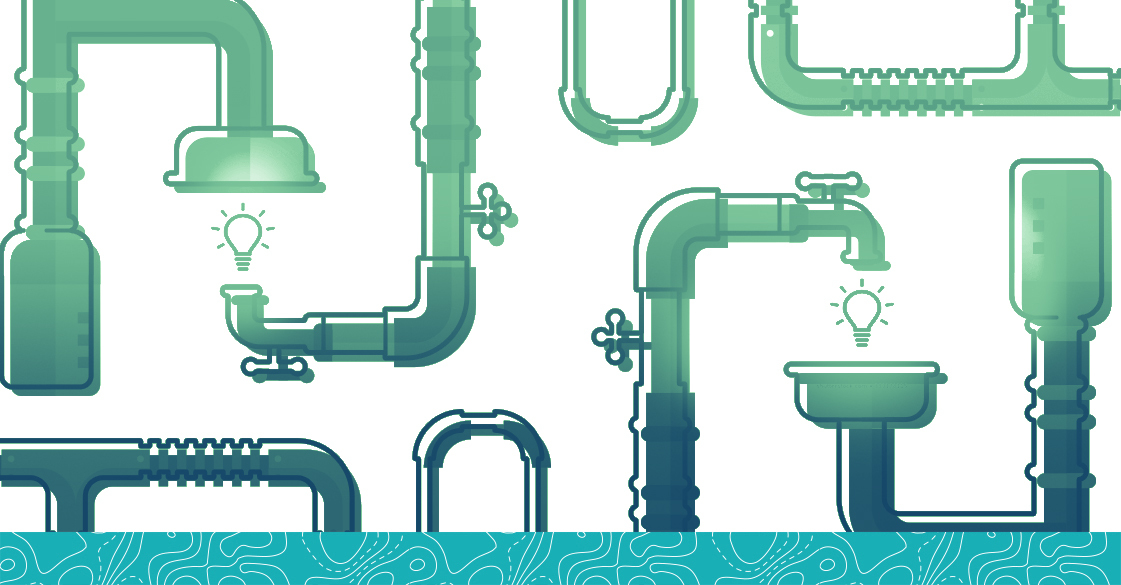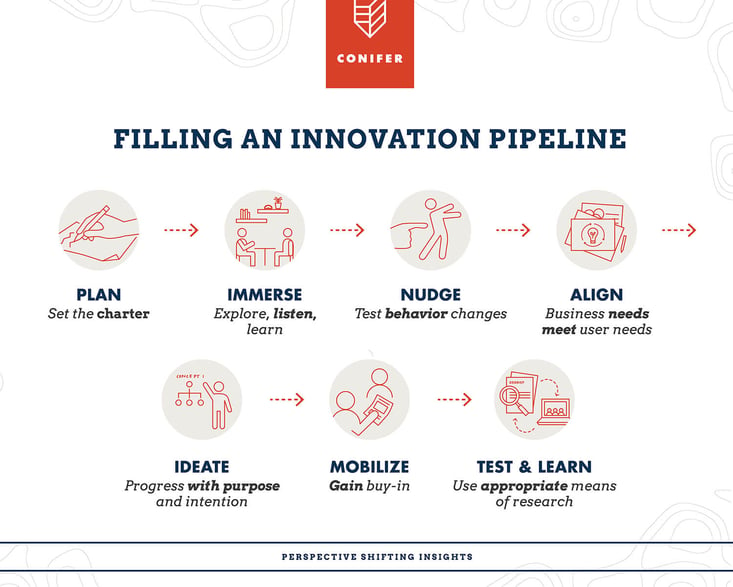
Conifer's 7 Steps to a Healthy Innovation Pipeline

Being tasked with filling an innovation pipeline can be exciting, inspiring, but also daunting. The opportunity to pave the way to the future carries a heavy burden: the weight of looming business decisions or acquisitions can ride on one of these programs. These investments often come with lofty revenue goals on top of the extra attention from executive stakeholders. Innovation managers have to wrestle not just with those pressures, but also with timelines, accelerated by the pace of the market forces, and ever-present R&D pressure to test the bounds of what is and is not possible.
Under these conditions, it can be all too tempting to move too fast, skip steps, or fall back on “me too” innovation or old ideas. But this can be costly in the long run because skipping the research and needs definition stage can lead to missing an opportunity for years, or forever. Shortcuts may yield incremental innovation, while rigorous qualitative research to explore short- and long-term opportunities can pack your pipeline.
When it comes to taking on these programs, you want a partner who can help you navigate the stage-gates of moving from the early impetus to actualizing the idea. There are infinite frameworks you can use to guide your innovation. We, too, have used many of these and they distill down to a basic triangulation that you will need to chart a path forward. But in order to get from point A to B, there are many micro-steps in between. The Conifer team has mapped out some key moments, along with their main objectives, for a path to a successful and robust innovation pipeline.

1. Planning
Main Objective: Set the charter and vision for the path ahead.
Often skipped or shortchanged, give planning the credit it is due. It is here where a true “lay of the landscape” is acquired, where expectations are set, stakeholders are heard, and where the team is motivated to stay curious, open-minded and to embrace the comfort of ambiguity to come.
Before anything else, you should give your team a solid understanding of the project’s foundation. Interviews with experts, futurists and internal stakeholders should all be on your pre-flight checklist to make sure you’re going in smart and level-set. The team should coalesce around the right audience and research methods, and come together for a well-planned kick-off workshop to document assumptions, hypotheses and open questions that your stakeholder team has. Save these for later — they will mark your progress and shifts in perspectives as the project unfolds.
2. Exploration and Immersion
Main Objective: Listen, learn and avoid jumping too soon to solutions.
Even the most visionary of designers need first-hand inspiration. This comes from the open-ended exploration of users' lives and worlds. Don’t skimp here. Stay curious and be ready to be inspired and enamored by users’ workarounds, needs and problems. It is easy to say “we’ve already done our research on this...” but when it comes to innovation pipeline programs, your research needs to be as timely as possible. All that great data from last year’s study may be a good starting point, but consumers' needs and expectations can change dramatically. Don’t forget to take the time to explore beyond the bounds of the exact experience you are studying: the best immersions help break teams out of narrow/incremental thinking by exploring analogous experiences or even far-flung alternates for inspiration.
3. Behavior Nudges
Main Objective: Understand the possible implications of disruption, behavior changes and nudges to leapfrog ahead
Like product development, learning and discovery are iterative — it’s for this reason Conifer implements a second, more focused phase of research following the first. This provides space for new lines of questioning and fresh “what if” thinking. We ask ourselves where might people change (or resist change) and explore what disruption looks like by running creative behavioral prototyping experiments through methods like Deprivation. For example, what happens if users go without their preferred products for a period of time? Do they find something newer and more exciting to use? These behavioral nudges and micro-experiments help us better understand how flexible users are today, which has huge implications for new innovation concepts.
4. Insight Alignment
Main Objective: Aligning business needs with user needs.
You’ve done your homework, conducted rigorous research and your brain is steeped in the potential of what could be. At this stage, insights and user needs are synthesized, sharpened, and summarized. User stories are visualized, data is brought to life, pain points are mapped, frameworks are created, insights and emerging opportunity spaces are sketched out. At the same time, we begin aligning what we heard in the research with the business goals and core capabilities in mind, finding sweet spots between users and actionable future business decisions.
5. Ideation and Activation
Main Objective: Moving forward with purpose and intention.
Opportunities and needs have been sharpened and now it's FINALLY time to do what everyone has been waiting for: develop new ideas. Ideation sessions often require some forethought regarding how best to channel team energy and inspire creativity. Get teams thinking beyond one solution space by using tools like 10 Types of Innovation. People can get intensely passionate in the ideation stage. They may be too invested in their own ideas or can become stuck when they dismiss a major business opportunity as “too hard.” This is when we must remember that innovation is never easy and that the first iteration of an idea is almost never the one that wins.
Getting traction for new ideas has a tried and true process that can unfold quickly within a Design Sprint.
- Generate ideas: Your team's task will be to fill the walls — the more ideas the merrier. And remember, there are no bad ideas. Make time at regular intervals to share out and discuss — building on each others concepts.
- Cluster & Prioritize: Identify themes, patterns and complementary ideas. Prioritize key directions to explore further. As you cluster and prioritize remember to document everything — you never know when you will need to go back!
- Iterate: Build out early ideas through design planning activities such as storyboarding and drafting value propositions. Can concepts be connected, expanded into full ecosystems, or are there connections and efficiencies from a service design, brand or manufacturing point of view? During iteration, maintain a breadcrumb trail from the original user insights, pain points and needs: you don’t want to end up too far from the original need you are addressing. Teams should also document any foreseeable challenges or roadblocks that may be encountered or envision what the exact next steps might be.
- Pressure Test: Before too much investment is put into design iterations or renderings, make sure that prioritized concepts are pressure tested by key internal metrics. To do this you, take a critical look at where the concepts sit in the overall innovation roadmap: is it a Step (executable in the short term), Stretch (may require additional refinement or exploration) or a Leap (may take a big business move or significant investment to develop)? Does it meet the litmus test of Desirability, Viability, and Feasibility? (We here at Conifer like to refer to this as the “Diane Von Furstenberg Pressure Test.")
6. Gain Momentum
Main Objective: Get buy-in for business mobilization.
That was fun, but sorry, you’re not done quite yet! An innovation pipeline is just a launching point — at the end of Step 5 you should have a whole catalog of concepts with a range of ideas to fuel the business over the next 1–5 years, and now it’s time to get the organization working. Every company is different when it comes to taking the next steps depending on the structure of the organization and tolerance for risk and experimentation. Some teams have the autonomy to roll up their sleeves and begin to make, while others must create business cases, size the opportunity, or run ideas through quantitative concept screening. Some teams even “shop the Concept Catalogue” to different groups to see who can act on what.
7. Test and Learn
Main Objective: Explore prototypes and gather user feedback through the development process.
The focus here becomes on getting it right, with a continuous commitment to iteration, improvements, and eventually making it real and integrating it into the real world. Concept testing, Living Labs, Co-Design and live market tests are some of the many future methods that you’ll want to employ to move from idea to a minimum viable prototype through your go-to-market strategy.
